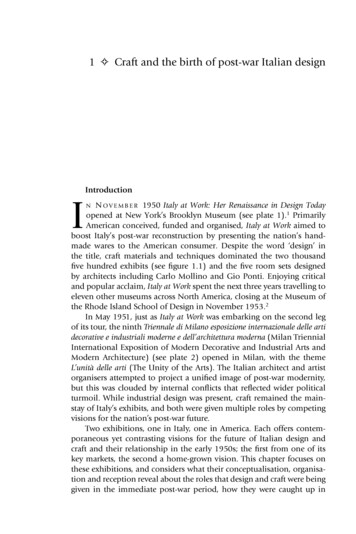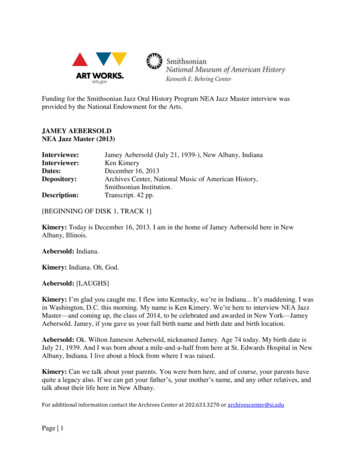
Transcription
1 Craft and the birth of post-war Italian designIIntroductionn o v e m b e r 1950 Italy at Work: Her Renaissance in Design Todayopened at New York’s Brooklyn Museum (see plate 1).1 PrimarilyAmerican conceived, funded and organised, Italy at Work aimed toboost Italy’s post-war reconstruction by presenting the nation’s handmade wares to the American consumer. Despite the word ‘design’ inthe title, craft materials and techniques dominated the two thousandfive hundred exhibits (see figure 1.1) and the five room sets designedby architects including Carlo Mollino and Gio Ponti. Enjoying criticaland popular acclaim, Italy at Work spent the next three years travelling toeleven other museums across North America, closing at the Museum ofthe Rhode Island School of Design in November 1953.2In May 1951, just as Italy at Work was embarking on the second legof its tour, the ninth Triennale di Milano esposizione internazionale delle artidecorative e industriali moderne e dell’architettura moderna (Milan TriennialInternational Exposition of Modern Decorative and Industrial Arts andModern Architecture) (see plate 2) opened in Milan, with the themeL’unità delle arti (The Unity of the Arts). The Italian architect and artistorganisers attempted to project a unified image of post-war modernity,but this was clouded by internal conflicts that reflected wider politicalturmoil. While industrial design was present, craft remained the mainstay of Italy’s exhibits, and both were given multiple roles by competingvisions for the nation’s post-war future.Two exhibitions, one in Italy, one in America. Each offers contemporaneous yet contrasting visions for the future of Italian design andcraft and their relationship in the early 1950s; the first from one of itskey markets, the second a home-grown vision. This chapter focuses onthese exhibitions, and considers what their conceptualisation, organisation and reception reveal about the roles that design and craft were beinggiven in the immediate post-war period, how they were caught up inn
Craft and the birth of post-war Italian design1.1 Installation view of Italy at Work: Her Renaissance in Design Today at Baltimore Museum ofArt, including table and chairs designed by Carlo Mollino, 1953.the cultural, national and international politics of the period, and howthese key vehicles for the dissemination of Italian design and craft wouldinform their shape for years to come.A handmade reconstructionItaly at Work was part of a larger number of American-led initiativesaimed at resuscitating Italy’s post-war economy. Between 1944 and1954 Italy received 5.5 billion in aid from the United Nations Reliefand Rehabilitation Administration (UNRRA), the Interim Aid programand the European Recovery Program, better known as the MarshallPlan.3 This assistance was not without political motivation: the late1940s and early 1950s were overshadowed not just by the fallout fromthe end of one war, but the threat of another – the Cold War. Americawas concerned at Italy’s leftist leanings: the Partito Comunista Italiana(Italian Communist Party (PCI)) was the largest communist party inEurope, and in 1945 it shared power in an anti-Fascist alliance withthe Democrazia Cristiana (Christian Democrats (DC)) and otherleft-wing groups.4 This did not last long. In 1947 the DC dissolved11
12Crafting design in Italyits collaboration with the PCI and won a convincing majority overthe Communist–Socialist coalition in the April 1948 parliamentaryelections. America’s role in this political shift has been extensivelyexamined.5 As the elections approached the amount of American aidincreased and the terms on which it was given made clear: in early 1948the Secretary of State George Marshall (after whom the Marshall Planwas named) warned that ‘all help to Italy would immediately cease inthe event of a Communist victory’.6Building on a perceived link between economic prosperity andreduced Communist support, American support for Italy’s craft industries was framed by this anti-Communist propaganda: the New YorkHerald Tribune was amongst several American newspapers to promoteItaly at Work as a way ‘to enable Italy to help itself more successfully inthe effort to shield the country against misery and Communism’, twophenomena seen as different sides of the same coin.7Supporting Italy’s rehabilitation also made economic sense, for bothnations. Italy had to rely on heavy exporting to compensate for extensiveimporting as high levels of unemployment and low wages for those inwork limited its domestic market. This situation was exacerbated by theItalian government’s plans for post-war economic development, whichprioritised exports over domestic consumption in order to improve thenation’s balance of payments and international competitiveness.8 Thisstrategy also saw certain industries prioritised over others; the Italiangovernment gave financial incentives to textile exporters, mindful of anAmerican market keen on its woven wares.9 Enabling Italy to be a tradingpartner was also important for America, as it attempted to avoid theeconomic downturn of its European allies.10Max Ascoli and the House of Italian HandicraftItaly at Work was not the first American-led initiative that actively promoted craft, and it was enabled and shaped by these earlier activities.Chief amongst these were the philanthropic efforts of the Jewish-Italianémigré Max Ascoli, who had emigrated from Italy in 1931 to escapepolitical persecution. In 1945 Ascoli set up Handicraft DevelopmentIncorporated (HDI), a non-profit organisation for what the New YorkTimes described as ‘the rehabilitation of Italian handicraft for export tothe American market’.11 This external focus would feed into every aspectof both HDI and Italy at Work, particularly in terms of the emphasis ondeveloping craft rather than industrial manufacture in Italy. While Italywas only part industrialised in 1945, less than 10 per cent of the 1938value of the country’s industrial plants had been destroyed and the engineering industry had actually grown during the Second World War.12 If
Craft and the birth of post-war Italian designAmerica encouraged Italy’s industrial development it would only createcompetition for its own producers, and Ascoli knew he needed to showthis would not happen. According to the New York Times he ‘emphasizedthat there would be no attempt to compete with established trade’,a reassurance later repeated by Italy at Work’s curators, and one thatwould inform what direction Italian production would be encouragedto take.13Under Ascoli’s guidance, HDI engaged in a three-stage strategy tohelp Italy’s crafts: first boosting production, secondly exhibiting theresults to create an appetite and thirdly enabling consumption throughselling Italian wares. The first was crucial: facing a country whose paucityof natural resources had been exacerbated by wartime sanctions and apolicy of autarchy, from 1945 HDI exported materials including lace,leather and metal through UNRRA to Italy’s artisans, alongside toolsand equipment, such as seven electrical kilns to the historic ceramictown of Faenza.14 It also offered technical and artistic advice through theComitato Assistenza Distribuzione Materiali Artigianato (Committeefor the Assistance and Distribution for Craft Materials (CADMA)), aFlorence-based organisation Ascoli set up at the same time as HDI andwhich had representatives across Italy.CADMA organised competitions for local artisans and from 1947exhibited selected results at the Handicraft Development Incorporationorganisation’s New York headquarters, called the House of ItalianHandicraft (HIH), a three-storey brownstone with an interior designedby the American-based Italian architect Gustavo Pulitzer (see figure 1.2).On the showroom’s opening, products including ceramics, glass, porcelain, lingerie and leather handbags were all displayed.15 At this stage,visitors could not yet buy goods directly from the showroom, andinstead were directed to department stores including Abraham & Strauss,Lord & Taylor and Macy’s, who had been carrying Italian goods since the1920s.16The HIH organised a number of exhibitions in this second stage ofactivities. In June 1947 came Handicraft as a Fine Art in Italy, consistingof objects conceived by architects and artists including Lucio Fontana,Renato Guttuso, Fausto Melotti, Giorgio Morandi and Sottsass, andmade by anonymous artisans. In stark contrast to the photographs andbiographies of the artists and architects involved, the catalogue gives nodetails of the artisans who actually made the products.17 Their anonymity and the limitation of their role to that of executing another’s ideas,rather than realising their own, would both be hallmarks of the artisan’sexperience and representation in post-war Italian design more generally.It seemed that the artisan could not be left alone, and craft’s economicand cultural significance would only continue if it was endowed with the13
14Crafting design in Italy1.2 Interior of the House of Italian Handicraft, New York, 1948.contemporary forms of expression that only architects and artists couldprovide.In January 1948 Sottsass and several others from this exhibitionparticipated in Vita all’aperto (Outdoor Living). Together with architectsincluding Ernesto N. Rogers and Ignazio Gardella they created a number
Craft and the birth of post-war Italian design1.3 Vita all’aperto (Outdoor Living) installation at the House of Italian Handicraft, New York,1948.of room sets (see figure 1.3), in which neo-rationalist modular metalshelving units were used to display craft products. This co-existenceof industrial and artisanal modes of expression could be seen to bein tension. Rather it embodies what Sparke has described as design’sopenendedness in the early 1950s, as well as an embryonic, supplemental status in relation to craft that the shelves’ supporting role quiteliterally suggests.18Writing about the exhibition in Domus, Ponti had much praise forVita all’aperto, as it presented craft that was designed by Italian architectsand artists and which, compared to other export-orientated industries,was not corrupted by the American market.19 Ponti chastised Americanbuyers who had the same ceramics made in the Veneto as in the Abruzziregions, the same lace in the Northern town of Cantù as in Florence, acost-cutting exercise that negated the regionalism of Italy’s craft traditions and was ‘corrupting not only the hands and minds of the executors,but also the taste of us consumers!’20 However, what Ponti wanted forItaly’s crafts only went so far. When HDI initiated its third and final retailstrategy it was not Italian architects but the American consumer whodetermined the design of the objects sold.In spring 1948 HDI entered its third and final phase – retail. Keento ensure its stock would meet American taste, the organisation sent out15
16Crafting design in Italyquestionnaires to four thousand retail outfits to find out what productswould most appeal. They would use this to decide which materialsto make available to Italy’s artisans, using a five million dollar loanthat Ascoli had negotiated from the Export-Import Bank.21 In order toadminister the loan effectively, Ascoli merged CADMA and the House ofItalian Handicraft into the Italian-based Compagnia Nazionale Artigiana(National Artisan Company (CNA)), and temporarily closed the HIHwhile they ascertained how best to direct Italy’s exports.The questionnaire showed that ceramics were the most popular typeof craft objects and that American consumers preferred bright colours,unusual forms and ‘traditional’ designs.22 When the HIH reopenedas the Piazza in November 1949, the latter prevailed. Although therewere some design-led pieces, also on sale were salt and pepper shakersin the shape of ‘miniature Chianti wine bottles’ and painted ceramicjam jars that clearly went against Ponti’s vision for craft’s design-ledfuture.23The Piazza proved popular, particularly in terms of its craftproducts – sales of Italian furniture, straw baskets, marble, alabaster and Sardinian textiles all increased following their display at thePiazza, and in the first six months of 1948 Italian exports to the UStotalled nearly fifty million dollars, more than for the whole of theprevious year.24 It suggested that if Italy at Work was going to sell Italy’srenaissance in design, it would have to take account of this preferencefor craft first.Italy at WorkAmongst the visitors to the HIH in 1949 was Meyric Rogers, curatorof decorative arts at the Art Institute of Chicago (AIC). For Rogers, itsopening was the first ‘tangible evidence of what was happening’ in Italy’spost-war crafts.25 It was also the first step towards Italy at Work: following his visit Rogers contacted Ramy Alexander, the CNA’s Americanvice-president, about the possibility of an exhibition of ‘the presentachievement of Italian designers and craftsmen in the various fields ofthe decorative industrial arts’.26That summer Rogers visited Italy. He and Alexander toured studios,workshops, schools and shops in and around Italy’s centres of craft production including Rome, Naples, Florence, Milan and Venice.27 Althoughsufficiently impressed to think that an exhibition was viable, Rogerswas not keen on everything he saw. His praise for furniture companiesincluding Milan’s Artigianato Produzione Esportazione Milano (CraftProduction Exportation Milan (APEM)) and Azucena was tempered withcaution that ‘the industry as a whole, where not guided by the more
Craft and the birth of post-war Italian designprogressive architects and designers, produces either clever copies ofthe antique or flashy pseudo-modern suites’.28 Similarly, he admiredVenetian jewellery ‘in spite of the quantities of tourist trash’, and had thesame selective praise for the glassware of Venini, Seguso and Barovier &Toso.29On his return Rogers contacted Charles Nagel, the director of theBrooklyn Museum, to see if he would be interested in hosting the exhibition.30 He invited the industrial designer Walter Dorwin Teague toserve on the selection committee, and in June 1950 they travelled to Italywhere they were joined by Alexander and two CNA representatives – theAmerican Richard Miller and Italian Alberto Antico.31 Together theytoured over two hundred and fifty producers, schools, exhibitions andshops to identify exhibits.32 These were then collected together in thebasement of Florence’s Uffizi gallery before being shipped to NewYork.33Rogers’s selection criteria promoted a more modern design aestheticcompared to the Piazza: ‘any object could be chosen provided it wasnot purely traditional in design and satisfied a high standard of qualityin form and color in relation to its material and purpose Naturallymuch credit was given to sincerity of craftsmanship.’34 The emphasis oncontemporary design meant that little alabaster was deemed suitable forinclusion, and Naples’ traditions of coral, cameo and ivory were similarly left out for being an ‘unresolved problem’.35There were also economic restrictions. The Italian government hadagreed to pay for the exhibits in return for the profits on ticket sales, buttheir limited funds prohibited precious metals or gems being included.36Other materials were rejected for not being sufficiently craft-like. DorwinTeague noted their difficulty in deciding when a ceramic work was craftand not art, considering an object ‘admissible’ if it was made from clayand not bronze or marble.37 This medium-based definition, one of theconventional ways that craft is defined, resulted in a heterogeneousrange of ceramics, from dining services semi-industrially produced bythe Florentine firm Richard Ginori (see figure 1.4) to the one-off waresof the Campania-born Guido Gambone (see figure 1.5), whose primitivist anthropomorphic and zoomorphic vessels were widely promoted byboth American and Italian commentators as contemporary updates ofItaly’s ceramic tradition.Gambone was part of a bigger clay-based revolution happeningin Italy at that time. This was centred in the Ligurian coastal town ofAlbisola, which had become a hotbed of futurist experimentation earlierin the century and now attracted international and Italian artists such asPablo Picasso and Fontana, the Argentine-born founder of Spatialism,and an artist who challenged the conventional dimensionality of canvas17
18Crafting design in Italy1.4 Tea set, vase and plates, manufactured by Richard Ginori, Florence, c. 1949 and shown inthe Italy at Work exhibition. Porcelain.and clay with his built-up, slashed and punctured surfaces.38 Yet whileFontana’s abstract, experimental approach to ceramics was championedin Domus, it was largely lost on the American public.39 Rogers noted thatFontana’s ‘daring and ingenuity’ are ‘somewhat difficult for an untrainedpublic to appreciate – particularly in this country’.40 While most of theshow’s exhibits were distributed amongst participating museums on itsclosure, Rogers suggested that Fontana’s were given to Dorwin Teague,who had greatly admired them, as none of the museums had expressedany interest.41Craft politicsThe emphasis on craft also contributed to the other near-absence inItaly at Work: industrial design. Compared to the twenty-six pieces ofhandmade furniture featured in the catalogue, including marquetry bythe Bolognese cabinetmaker Enrico Bernardi and woven-straw-seatedchairs by the Florentine furniture maker Guglielmo Pecorini (seefigure 1.6), there were just four industrial design objects: an Olivettitypewriter and electronic calculator, a Robbiati espresso machine andLambretta scooter.42
Craft and the birth of post-war Italian design1.5 Ceramic figure made by Guido Gambone and featured in Domus magazine, 1950.To an extent, the motivations for this emphasis on the handmadewere the same as those of HDI. Rogers echoed Ascoli with his assurance that ‘this movement for the enrichment’ of Italy’s crafts ‘supplements rather than competes with [our] own production’, addingthat America’s increasing demand for the handmade far surpassed whatItaly’s crafts practitioners could produce.43Rogers attributes this rise in demand to the moral and ideological values he sees in craft: it fulfils ‘needs, material as well as spiritual,which can be supplied only by the enjoyment and practice of individualskills’.44 Both Dorwin Teague and Rogers repeatedly refer to the qualities of the individual in the catalogue and promotional articles, and thelatter identifies individualism as a key craft quality. While not opposed19
20Crafting design in Italy1.6 Two chairs with wooden frames and woven raffia seats and backs, designed and made byGuglielmo Pecorini, Florence, c. 1949, shown in the Italy at Work exhibition.to industrial production outright, Rogers saw a need for the handmadetoo. He described craft as offering ‘a necessary counter-balance to thelifeless monotony of purely mechanical production’, echoing larger1950s American craft discourse that was itself informed by arts and craftsideology.45This ideological appropriation of craft permeated the selection ofexhibits – objects were prioritised that either demonstrated the individual maker’s mark, such as Gambone’s ceramics or the sgraffito ceramicsindividually decorated by the Bergamo artist Franco Normanni for theMilanese firm Arte Artigianato Orobico (see figure 1.7), or referencedthe vernacular, such as Pecorini’s straw-seated chairs. These objectstypify what Sparke calls the ‘Janus’ nature of Italy at this time, looking‘back’ towards craft and ‘forward’ towards a modern design aesthetic andtherefore serving a key transitional role in the path towards post-warmodernity.46It is significant that Rogers found this quality of craft individualismnot in America, but in Italy. Rogers seeks an alternative to the alienationof mechanised modernity not by returning to handicrafts in his owncountry, but by encouraging its continuance in Italy. He defends Italyfrom its persistent stigma of backwardness, but still asserts a cultural
Craft and the birth of post-war Italian design1.7 Dinner set, made by Arte Artigianato Orobico, Milan, 1950, shown in the Italy at Workexhibition. Black sgraffito with chartreuse centre.difference based on its less industrialised condition.47 The exhibitionand the surrounding rhetoric repeatedly construct Italy as America’snon-industrialised, non-modern ‘other’, in which the spatial separationbetween America and Italy, and the former’s superior economic andindustrial might, is translated into a temporal difference.This perceived co-joined spatial–temporal difference exposes a quasicolonialist aspect to Italy and America’s relationship in the exhibition. Itechoes the writings of the post-colonial theorist Homi K. Bhabha, whodismisses the idea of ‘cultural contemporaneity’ in the perception ofthose located temporally or spatially elsewhere.48 Similarly, the anthropologist Johannes Fabian has argued that there is ‘no knowledge of theOther which is not temporal, historical, a political act’.49 Just as Rogersrepeatedly constructs Italy as a traditional, craft society rather than amodern, industrial nation, so the anthropologist denies his subject iscoeval. Instead, the ‘other’ is located in a more authentic past and utilised to critique the more advanced present: ‘the posited authenticityof the past (savage, tribal, peasant) serves to denounce an inauthenticpresent’.50 This is seen in the repeated construction of Italy as a traditional, craft society rather than a modern, industrial, design nation, notjust in Rogers’s written rhetoric, but visually on the catalogue’s cover.21
22Crafting design in ItalyAuthenticity is a key craft concept, one that will be returned torepeatedly in this book. In Italy at Work craft’s authenticity and individualism are conflated with politically motivated praise for freedomof expression. As Rogers described, ‘for years the individualistic energiesof the people had been repressed and canalized by totalitarian controlsbasically foreign to their temper’.51 In the Cold War context, Fascismand Communism were conflated as two equally noxious forms of nondemocracy that suppressed individual freedom. As a New York Journalwriter put it: the ‘taste of dictators, whether Fascist or Communist,obviously runs in the same uninspired groove’.52 Nor were the curatorsinnocent of this politicised taste. Nagel derided the furniture selectedfor them by Turin’s local government. Claiming to have been ‘politicallyinnocent’ of that fact that it was Communist-run, he added ‘I’m sureStalin would have loved every minute of it. It was the kind of conservative flub-dub stuff that Commies seem to love, and that sent Mussoliniinto raptures.’53The exhibits may have been free from the politics of Communism,but they were not without external influence. Several had been selectedfrom Florence’s CNA showroom, the organisation that directed thedesign of Italy’s artisanal products for export to America.54 Others werebought from the APEM store.55 Untangling what counts as an authentically Italian craft expression in this context is an ultimately futileproject; Italy’s artisans were always being directed by someone, whetherit was for domestic or international tastes. In order to see how differentthese geographies’ visions were, the next section examines one of theItalian-authored sections that were present within the American curatedexhibition – the room set.Gio Ponti’s room setFive especially designed interiors were included in Italy at Work. A fantastical dining room by Ponti (see figure 1.8) was joined by a living-diningroom by the Turinese architect Mollino furnished with his characteristically curvaceous furniture, an outdoor terrace by the Neapolitan architectLuigi Cosenza, a foyer for a child’s theatre by the artist Fabrizio Clericiand a private chapel by the Milanese architect Roberto Menghi.56In comparison to the other room sets, Ponti’s dining room was a collaborative effort. Ponti designed the freestanding and built-in furniture,the latter alternately hidden or revealed by mechanised movable walls,all of which was made by the Milanese cabinetmaker Giordano Chiesa.57The surreal decoration of flowers and butterflies on the walls and furniture was by the Milanese artist and decorator Piero Fornasetti, anotherregular Ponti collaborator. The Sardinian artist Edina Altara painted the
Craft and the birth of post-war Italian design1.8 Dining room installation designed by Gio Ponti for the Italy at Work exhibition, 1950.mirrored door at the back of the set, while the sculptor Melotti conceived and made the large neo-classical ceramic figures of Orpheus andEurydice on the shelves at the left-hand side. The rest of the ceramicswere designed by Ponti and made at Richard Ginori, where Ponti hadbeen art director since 1923.58Ponti’s collaboration with firms such as Richard Ginori, Fontana Arteand Christofle is one of the reasons why he is rightly held up as a patronof Italy’s craft tradition. As an editor, architect, curator, director of severalMonza Biennali and co-director of a number of Milan Triennali, Pontipromoted and worked with those practitioners and firms that he sawas exemplary. His relationship with craft was far from one dimensional,but informed by a multiple, and hierarchical view of the crafts and theartisans he worked with. At one end were the artisti-artigiani (artistartisans), men like Fornasetti, Gambone and Melotti, and occasionallywomen like Altara, whom Ponti endowed with a freedom of creativity.59These were the artisans Ponti was most interested in, as he made clear inan 1959 issue of Zodiac magazine, in which he, alongside several otherarchitects, critics and commentators including Giulio Carlo Argan andSottsass were asked to assess the state of Italy’s crafts.60 As Ponti stated,‘my interest [is] in the handicraft of “artists”, that is of cultured men’whose work influences, rather than is influenced by, the marketplace – acategory that the architect firmly placed himself in.61At the other end of the spectrum were those largely anonymousartisans who executed Ponti’s designs. The fact that he named Chiesaindicates both his standing and the extensiveness of their collaboration.Chiesa worked on many of Ponti’s projects, including an early version23
24Crafting design in Italyof the Superleggera and furniture for both the architect’s home in Milan’sVia Dezza and the Pirelli building, the latter designed by Ponti in collaboration with Antonio Fornaroli, Rosselli and the engineer Pier LuigiNervi and opened in 1958.62 By 1960 adverts for Chiesa’s firm, ChiesaArredamenti, were appearing regularly in Domus, one of the many examples of the interconnectivity between Ponti’s roles as an architect andeditor and his use of the magazine as a vehicle for promoting his owntastes and preferences.63In Domus Ponti had high praise for Chiesa: ‘The furniture and theentire installation was made with extreme perfection and passionateattention by a master cabinetmaker Giordano Chiesa of Milan, a manof great experience and infinite resources.’64 His admiration rested onhis skill as an executor, rather than an artistic figure. As Letizia FrailichPonti, the architect’s youngest daughter who worked for her father in thisperiod, later confirmed, Chiesa was ‘a marvellous executor, not creativebut technically perfect’.65Ponti made clear that he did not himself realise any of the objectshe conceived. The architect described his role as that of designing ‘forable hands – not to work as a potter but to develop designs for pottery’.66He denied that what he did was ‘directing’ artisanal activity: ‘we do notdirect anything, as we could make such mistakes!’67 Instead, Ponti calledthis an activity of ‘suggestion’.68This was the case with the white ceramic Scacchi freudiani (FreudianChessmen) included on the right of the room set (see figure 1.9). InDomus, Ponti described these as ‘giant chess pieces, cleaved open, whichrevealed the thoughts – confessed and not – that harbour in the chestof the king (weapons and women), the queen (the jack), the jack (thequeen), the knights (mares)’.69 He admitted that the ceramics werenot his original idea, but ‘a Pontian invention already beautifully realised by Andrea Parini’, examples of which were included on the nextpage.70 Ponti’s ‘invention’ was to translate the coloured, individuallydecorated and identifiably hand-moulded shapes of Parini (see figure1.10), a ceramist based in the Venetian town of Nove, into the allwhite, clean-lined and version for Richard Ginori, whose neo-classicalforms were more suited to the firm’s larger production scales. There isno mention of what Parini, the director of Nove’s art school, thoughtof this.71 He cannot have been too disgruntled, as he later sent photosof his work to be included in Domus, recognising the potential of suchexposure.72The appropriation of ideas was fairly common, and it ran bothways. According to the Italian architect and journalist Manolo de Giorgi,Chiesa took the ‘liberty of turning out “parallel” products’ based onPonti’s designs, and the architect was ‘almost flattered that his work had
Craft and the birth of post-war Italian design1.9 King from the Scacchi freudiani (Freudian Chessmen), designed by Gio Ponti and made byRichard Ginori, c. 1950. Porcelain.sparked a spate of copies’.73 This copying was one way that the collaborations between architects and artisans led to the diffusion of moderndesign on a wider scale in post-war Italy, as small workshops producedworks in the style of Ponti and others. Branzi later commented on thisin The Hot House: Italian New Wave Design: ‘this kind of indiscriminateand irreverent plundering permitted a renewal of form throughout themiddle ranks of Italian society a first sketch of modern Italy to takeshape in a provisional but complete fashion.’74Appropriation, whether a ‘Pontian invention’ or
Lord & Taylor and Macy’s, who had been carrying Italian goods since the 1920s.16 The HIH organised a number of exhibitions in this second stage of activities. In June 1947 came Handicraft as a Fine Art in I











